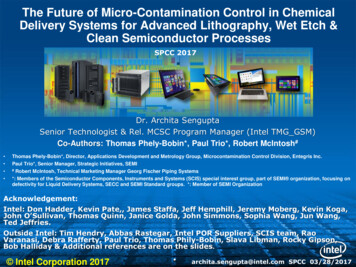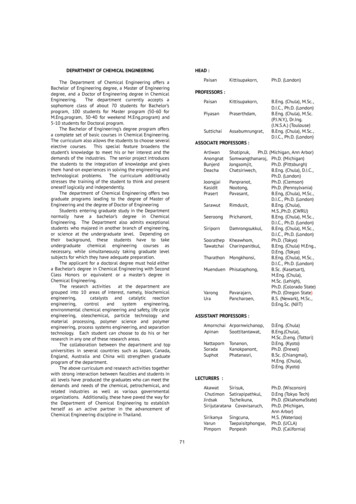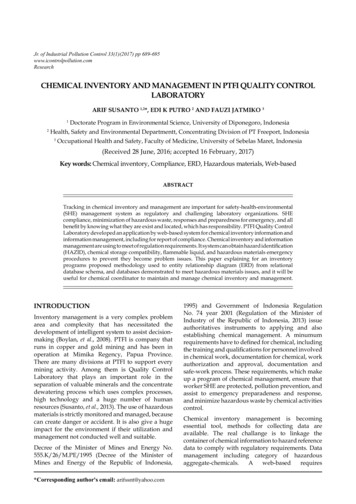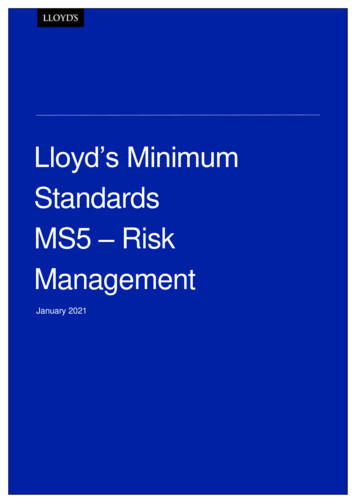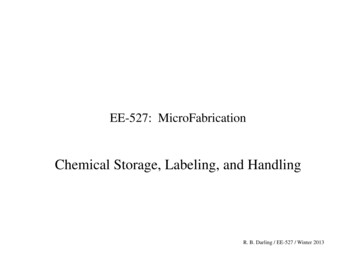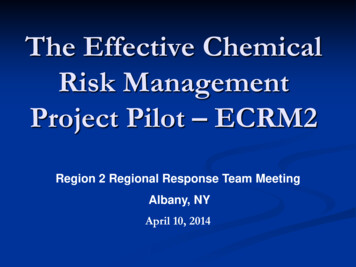
Transcription
The Effective ChemicalRisk ManagementProject Pilot – ECRM2Region 2 Regional Response Team MeetingAlbany, NYApril 10, 2014
ECRM 2 Desired Outcomes Evaluate various methods of assorting facilities(federal and state collaboration)Develop a method for ranking facility chemicalriskFormulate an “all hazards” understanding of riskthroughout the regionDetermine a process for assigning relative risklevels to facilities of greatest concern2
ECRM 2 Desired Outcomes Processes for collecting, storing, and usingfacility informationEnsure that local responders have access to keyinformation in a format that is useful to identifyand respond to risks at chemical facilitiesDetermine methods for getting chemical safetyand security information, and effective outreach,to stakeholdersIncorporate best practices from other regions3
ECRM 2 Desired Outcomes Assessment of the cost/benefit from theperspective of the facility ownerAssessment of individual agency points of viewof the usefulness/effectiveness of a jointinspection processFramework for scheduling, executing, andreporting a joint inspection4
Chemical Facility Safety and Security –ECRM 2 Pilot SOP Development Executive SummaryOverview Federal and State Programs – ChemicalFacility Safety and SecurityChemical Facility Safety and Security CriticalIssues Response Community SERCs/LEPCs Tier 2 Information – Chemical Inventory Managing Risk Data / Information Sharing Standard Operating Procedures Conclusion5
ECRM 2 Standard Operating Procedures –Development Sustained participation on the Region 2 RegionalResponse Team (RRT).One Call Location for Facility SpecificInformation.Joint Drills and Exercises.Incident Commander Standard for Senior FireDepartment Personnel.6
ECRM 2 Standard Operating Procedures –Development Specific HAZWOPER Training Standard forHazmat Responders. Electronic Tier II Data Management. Subject Matter Expert. Qualified Individual/ 24hr Facility Contact forFirst Responders.7
ECRM 2 Standard Operating Procedures –Development LEPC Best Practice Implementation. EPCRA Enforcement. Revised Inspection Protocol. Sustainability.8
ECRM 2 Standard Operating Procedures –Development Improving Coordination Among Federal andState Agencies on Programs, Roles, andContacts / Getting to Know You.Inter-Agency Inspection Information, DataRequests, & Database Access. Coordinated Inspections Cross-Cutting Issues.9
ECRM 2 Work Product – Development LEPC Guide to High Risk Chemical Facilities. Help LEPCs to do three things: Develop and maintain an inventory of high risk facilities in theirjurisdiction;Prepare for an incident at a high risk facility;How to/not to respond to an incident at a high risk facility.Help LEPCs get assistance fromfederal/state/county experts who can help withquestions and challenges in all three parts.10
ECRM 2 Work Product – Development Multi-Agency Guide to Inspecting High RiskChemical Facilities.Develop an "awareness" guide where agenciesidentify priority issues that present risks to publichealth and the environment from high riskfacilities. This could result in a manageable short listof key things to look for that other agencies key on.Inspectors can share and refer observed key issues sothat the responsible agency can follow-up.11
ECRM 2 Work Product – Realized Coordinated Inspections Conducted by a lead agency on an inspection alreadyscheduled for 2014 Other agency observers attend the inspection Training and awareness goal Sustainability given current resources12
Chemical Facility Safety and Security –ECRM2 Target Dates Apr 3, 2014 - ECRM2 Summary Report to the Sec 3/4Sub-workgroup on the National EO WorkgroupApr 15, 2014 Rough Draft SOPs shared with ECRM2 participants for reviewand commentComments and input wanted for other sections of the SOP planECRM2 Conference CallMay 1, 2014 - Comments and input needed from ECRM2participants on draft SOPs and plan content13
Chemical Facility Safety and Security –ECRM2 Target Dates May 12, 2014 - Adjustments made to all SOPs and theplan from received input. SOPs/Plan shared withECRM2 participants for second round of comment May 20, 2014 - ECRM2 face-to-face meeting May 27, 2014 - Comments due on the SOPs/Plan May 29, 2014 - Final SOPs and Plan completed andshared14
Regional Response Teams Short Term – Need information from the RRTs tosupport ongoing work of the National EO Workgroup First Responder, Best Practices, and ChallengesSERC/LEPC, Best Practices, and ChallengesTier 2 – Chemical Inventory, Best Practices, and ChallengesHigh Risk Facilities/ChemicalsData Information SharingLong Term – RRT issues going forward ECRM2 RRT ParticipationGeographic Differences15
13 Apr 3, 2014 - ECRM2 Summary Report to the Sec 3/4 Sub-workgroup on the National EO Workgroup Apr 15, 2014 Rough Draft SOPs shared with ECRM2 participants for review and comment Comments and input wanted for other sections of the SOP plan ECRM2 Conference Call May 1, 2014 - Comments and input needed from ECRM2 participants on draft SOPs and plan content






